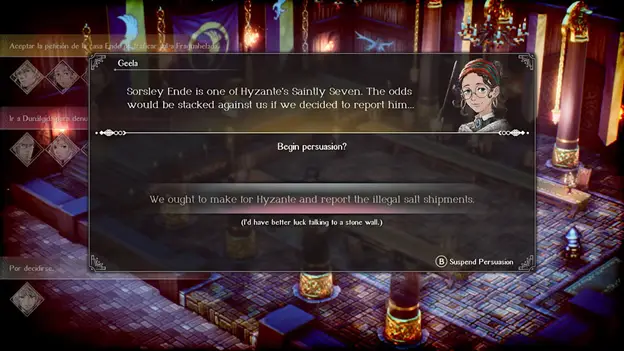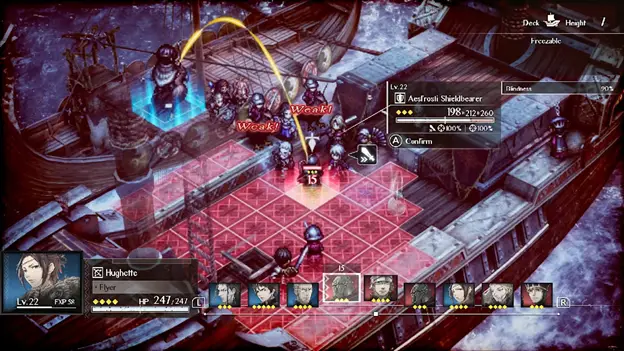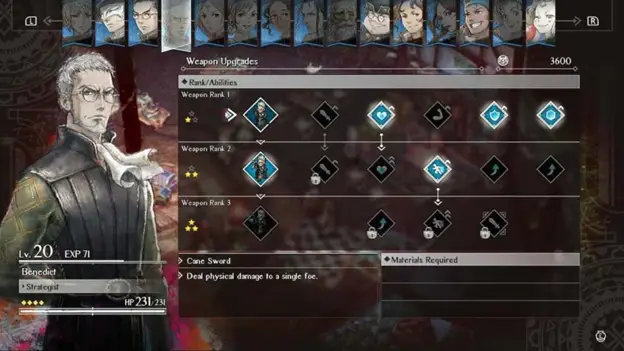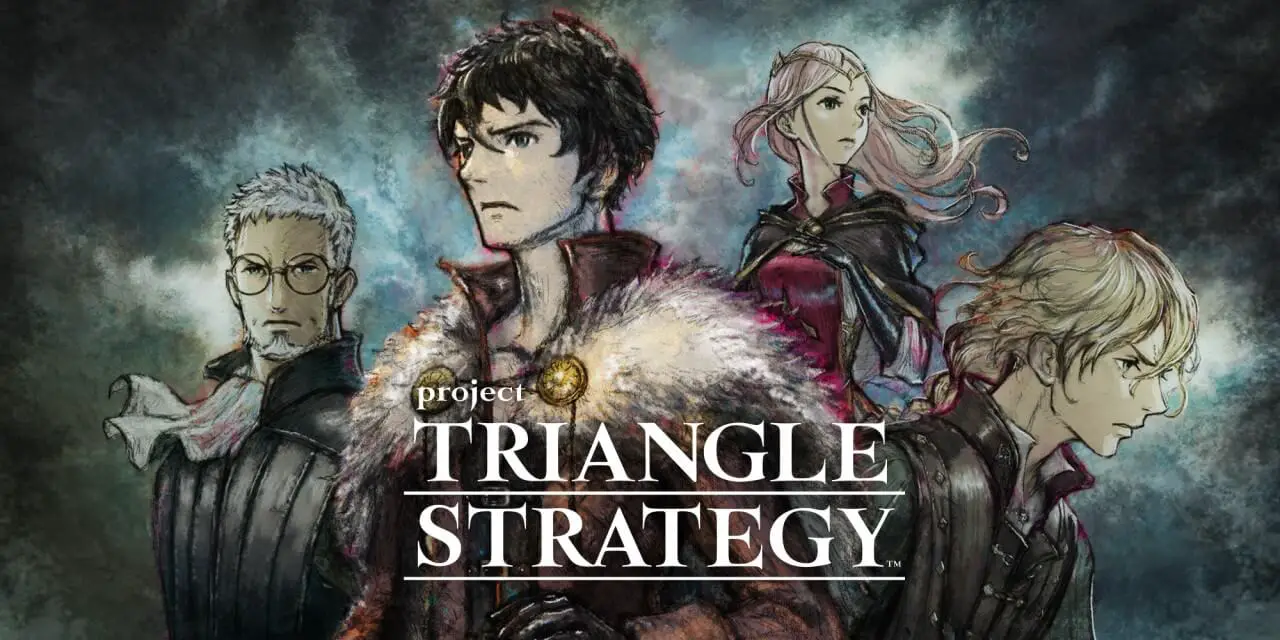Triangle Strategy, produced by Tomoya Asano (Octopath Traveler and Bravely Default) and published by Square Enix/Nintendo, is a traditional strategy role-playing game (SRPG) with a unique setting. Political tensions escalate between the three mighty nations, under the lingering shadow of a recently-ended war. The argument is over who gets to control the vital natural resources.
Overview
The Four Phases
Triangle Strategy follows the typical SRPG formula of alternating battles and story scenes – with limited exploration or interactive conversations. The gameplay consists of four main phases, without a particular order in which they happen.
The first phase is narrative. This typically involves characters interacting with each other, with no real contribution from the player. There are mandatory and optional narrative sections. You do have the ability to skip through them if you want – handy if you intend to replay the game.
The second phase is exploration. You wander around the map, interacting with characters and looking for hidden treasure. The characters mostly provide color commentary, but can also share information, useful during the other phases. In addition, there are usually two special NPCs who ask you to respond to certain questions. Answering these gives you a bonus to one of the three ethical frameworks.

The third phase is called Scales of Conviction. During it, your seven core party members vote on what path to choose. Here you can use your knowledge of their personality and information acquired during exploration to convince them to agree on one of two – sometimes three – options. These choices will have a big impact on your journey. They may result in different battles, different interactions, and even different recruitable characters.
The fourth phase is story battle. These are tactical turn-based battles that advance the story in some way. They feature a variety of victory and loss conditions, as well as special terrain effects. These aren’t the only battles, though. There’s also a fair number of replayable “mental battles”. Those, however, are a bit more generic and not particularly tied to the main game.
Combat
Combat is tactical and turn-based. The game uses an action time system: the greater a character’s speed – the more often they can move. In addition to speed, each hero has other, unique stats. Those can affect offense, defense, and mobility. Together, they determine how the character performs on the battlefield and when interacting with others. Elevation and position are especially important. Higher ground gives greater range, while attacking from behind results in an automatic critical hit. All this is typical in SRPG games influenced by Tactics Ogre and Final Fantasy Tactics. Still, Triangle Strategy does feature a few things that make it stand out.
First, it uses special Tactical Points to power abilities. A character starts with three TP, gaining an additional one at the beginning of their turn. The abilities vary in how useful they are without TP in reserve. Mages and healers are almost completely useless without these. Archers and warriors remain reasonably useful, and support characters are in-between. There are also numerous abilities that either give TP, transfer them, or provide bonuses if you have a lot.

Then there is the flanking system. Sometimes when you attack an enemy, in ranged or melee, there’s another character on the other side of that enemy. Generally, in this case, that other character is also able to attack, although the attack will be weaker. Much like with TP – and many other aspects of this game – there are many ways to modify this.
Finally, there are environment effects. Characters, especially mages and some archers, can change the terrain and get bonuses from it. Ice abilities create places that are more difficult to move through; lightning abilities can strike those who are connected to the original target through a chain of water tiles. Some characters get bonuses in certain weather. One can even change it, resulting in an interesting combination of interlocking synergies.
Characters
Triangle Strategy features two types of characters: those related to the story, and the recruitable ones. There are eight story characters in total, all joining the team early in the game. The recruitable ones are unlocked either by making specific progression choices, or by gaining points in one – or more – of the three ethical systems: Utility, Morality, and Liberty. Some of these characters you can easily unlock early on; others, though, you are unlikely to recruit until reaching New Game+. Each character has its own set of abilities and two ways of customization: weapon upgrades and accessories.
Many of a character’s unique abilities become immediately available with the appropriate level. Others require them to advance to their 2nd or 3rd tier first. Advancing tiers also increases the character’s stats. The materials required for this are limited, however. As such, you won’t be able to upgrade the entire party during a normal run. Luckily, not everyone requires the final level to be functional; while some characters get a lot more out of it than others.

Weapons and Accessories
Weapon upgrades are specific to the character; they are associated with their weapon and can’t be transferred. These bonuses come in three tiers. The materials required for unlocking them depend on how far you are into the game. Each tier also provides some abilities. Those you can purchase with a combination of entirely different materials and money. You must carefully decide whom you want to invest in. Even if you concentrate on a core group of ten – the most common number of characters in a battle – there still won’t be enough resources for all.
Accessories are equipable and, unlike weapon upgrades, transferrable. They provide a mix of bonus stats and additional capabilities. This even includes some abilities that are otherwise only available to specific characters. Some can be quite strong and role-defining. Many are unique. Therefore, you must seriously consider which character gets a certain accessory, and how they’ll use it.
Achievements and Triumphs
Put simply, Triangle Strategy is great. True, it isn’t going to be as revolutionary as games like Fire Emblem, Tactics Ogre, or Final Fantasy Tactics. However – in quality and fun, it is their worthy successor.
Triangle Strategy’s tactical battles are really, really good. They constantly introduce new environmental mechanics, requiring you to find new ways to win. Many of these features show that Triangle Strategy is pushing against the ruts and limitations SRPGs have sat in for quite a while. I do hope the future SRPG developers will notice what Triangle Strategy is doing – and continue to innovate even further.
While a dynamic battlefield was seen before, in Divinity: Original Sin series and Telepath Tactics, the Triangle Strategy‘s approach is unique. It takes advantage of multiple dimensions in a way that neither of them really attempted. In the same time, it’s able to maintain a fine line, allowing the player to do interesting things without breaking the game.
Despite its complexity, the game feels easy to play. With a single exception, the UI is extremely well done. It presents the information you need, exactly where you need it – and in a very attractive way. This is true even for those who are colorblind, like myself – with symbols being effectively combined with color variations to ensure that the information is readily available. It’s almost certainly unfair to compare this game’s UI to its indie competitors – you can definitely feel the budget in Triangle Strategy’s smoothness and attractiveness.
Character management is on point. Triangle Strategy has removed most redundant decisions, ensuring that the remaining ones are interesting and meaningful. This is especially important due to the number of characters you field on any given map. Most games with job-based systems give you at most six characters to control. Triangle Strategy typically gives you ten – who also vary throughout the game. Managing that many characters could easily become overwhelming if it wasn’t for Triangle Strategy‘s straightforward build system.
Failures and Limitations
Most of Triangle Strategy‘s failures are pretty inconsequential. Some voice acting is average; a few of the story choices seem rather short-sighted, assuming a basic level of competence; the initiative interface automatically recentering on whomever you select is more annoying than useful. None of these ruin the game, being just annoyances in the grand scheme of things. Well, unless you consider a perfect story to be vital for your video game experience. There are, however, two failures that I feel are a step beyond inconsequential and are worth discussing.
The first of these is the character balance. While most characters range from good to great in power level, there are a few that are severely underpowered – to the point where it would be unreasonable to use them on any but the lowest difficulties. Considering how well-designed most other heroes are, this is disappointing. I wish there was a bit more work put into making them useful.
The second issue is with the narrated summaries that pop up between chapters. They are repetitive and annoying and serve only to repeat the information you’ve just learned from playing the game. You can skip them – and the fact that you have to do it is a definite design failure; especially in a game with otherwise such a smooth gameplay experience.
Conclusion
Triangle Strategy is the best modern SRPG, and unless something surprising happens (which, to be frank, happens quite regularly), I fully expect it to be my game of the year. Although not perfect, Triangle Strategy manages to hit that sweet spot of interesting character progression, relevant story decisions, and tense, engaging battles.
The game is able to take the best things from previous SRPGs (it’s certainly not a coincidence that the battle system is so reminiscent of Final Fantasy Tactics) while adding its own well-thought-out features. If you own a Switch and like turn-based tactical RPGs, then you are doing yourself a disservice if you don’t play Triangle Strategy.







